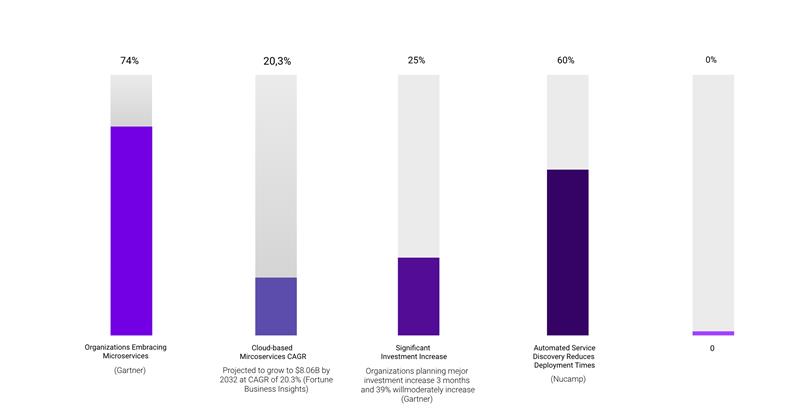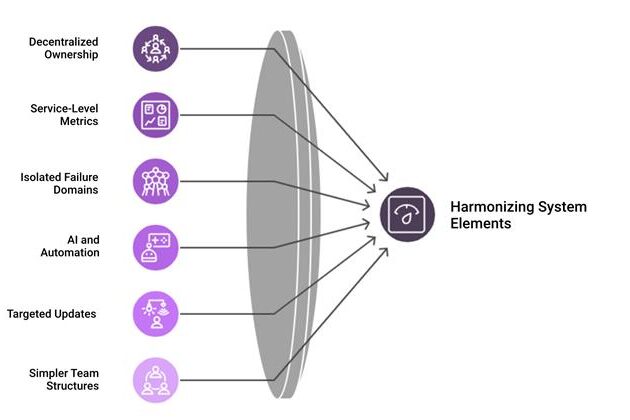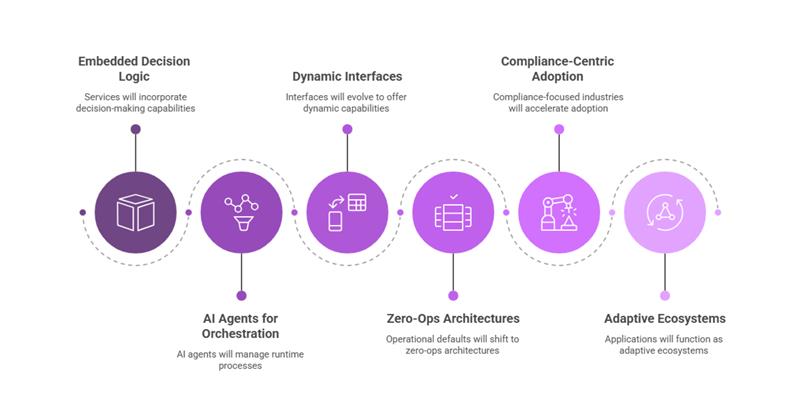Microservices architecture continues to dominate as the foundational approach for scalable, modular application design in modern software systems. APIs & containers together provide the agility and isolation needed for resilient microservice deployments, with APIs facilitating communication and containers ensuring portability. Orchestration & DevOps strategies are essential for managing microservice lifecycles, automating deployment, and maintaining continuous integration and delivery.
Detailed Definition & Explanation
Microservices architecture (often referred to simply as microservices) is a modern, distributed software design pattern that structures an application as a collection of loosely coupled, independently deployable services. Each microservice is designed to execute a specific business capability and operates as an autonomous unit with its own codebase, runtime environment, and data persistence layer.
In contrast to traditional monolithic architecture where all application logic is bundled into a single deployable artifact, microservices offer horizontal scalability, modular development, and agile delivery pipelines, making them ideal for cloud-native, DevOps-enabled, and real-time applications.
Characteristics of Microservices
- Encapsulates a single business function (e.g., inventory management, cart checkout, payment authorization).
- Own code repository & data store, supporting polyglot persistence (SQL, NoSQL, etc.).
- Independent lifecycle: Develop, deploy, and update without impacting other services.
- Lightweight communication via HTTP/REST, gRPC, or asynchronous messaging (e.g., Kafka, RabbitMQ).
- Containerized deployment (e.g., Docker) and managed with orchestration (e.g., Kubernetes) for auto-scaling, self-healing, and zero-downtime.

Key Components of a Microservices Architecture
- Service Registry & Discovery: Maintains a dynamic list of service instances and enables services to find each other without hardcoding addresses (e.g., Netflix Eureka, Consul).
- API Gateway: Central ingress that routes client requests, handles protocol translation, rate limiting, authentication, and request aggregation (e.g., Kong, AWS API Gateway).
- Load Balancer: Distributes traffic across instances to ensure high availability (e.g., NGINX, Envoy).
- Centralized Logging & Monitoring: Aggregates logs and metrics for observability and tracing (e.g., ELK Stack, Prometheus, Grafana).
- Security & Access Control: RBAC, API key validation, mutual TLS, OAuth2 for zero-trust security.
Types of Microservices
- Domain-Specific: Built around business domains using Domain-Driven Design (DDD) (e.g., “User Service” for authentication).
- Infrastructure: Provide reusable platform capabilities (e.g., authentication, email dispatching, file storage).
- Data: Specialized for data access/transformation, enforcing database-per-service to reduce coupling.
Why It Matters

- Decentralized Ownership Reduces Bottlenecks
Cross-functional teams own code, infra, monitoring, and SLAs end-to-end, improving deployment velocity and reducing coordination delays. - Service-Level Metrics Enable Faster Feedback
Individual telemetry (logs, traces, error rates, latency) accelerates experimentation and shortens the loop from code to outcome. - Isolated Failure Domains Improve Security & Reliability
Separate runtimes and data stores limit blast radius, containing faults and mitigating lateral movement by attackers. - AI & Automation at the Right Layer
Embed AI models close to data—e.g., recommendation engines within catalog services—to deploy autonomous micro-agents that optimize locally. - Targeted Updates for Regulatory Compliance
Update only relevant services (e.g., consent manager) when regulations change, avoiding full-stack redeployments. - Simpler Team Structures for Large Systems
Small, focused teams per service align with Conway’s Law, reducing inter-team coordination in large enterprises.
Real-World Examples
- Amazon: Transitioned from monolith to microservices for independent evolution of recommendations, reviews, payments, etc.
- Netflix: Handles millions of requests per second with independently maintained services like playback, search, and account settings.
- FD Ryze (Fulcrum Digital): Agentic AI platform built on microservices, allowing autonomous micro-agents (e.g., fraud detection, compliance) to deploy and scale independently.
What Lies Ahead

- Embedded Decision Logic: Services will adjust behavior based on real-time signals (e.g., adaptive fraud thresholds) without external orchestration.
- AI-Driven Orchestration: Runtime orchestration determined by AI agents reacting to system conditions (load, latency, success rates).
- Dynamic Capability Interfaces: Shift from static REST to intent-driven APIs, enabling clients and agents to select optimal call patterns.
- Zero-Ops by Default: Telemetry-aware agents automate scaling, remediation, and alerting, reducing manual ops overhead.
- Compliance-Centric Adoption: Regulated industries will isolate compliance boundaries, apply local policy changes, and maintain audit trails more easily.
- Adaptive Ecosystems: Services will self-regulate—monitor each other, trigger compensations, and scale proactively—shifting engineering toward rule definition.
Related Terms
- Monolithic Architecture
- Containers
- Kubernetes
- CI/CD
- API Gateway
- Service Mesh
- Event-Driven Architecture
- Orchestration
- DevOps
- Agentic AI
- Distributed Systems
